动词不定式时态
【精品】英语语法_动词不定式的时态和语态

I am glad to be talking with your brother.我很高兴正在和你哥哥谈话。 完成进行时
结构: to have been doing
概念: 在谓语之前开始发生,直到谓语发生时,不定式的动作依然在发生。
完成时 结构: to have done to have been 概念: 发生在谓语之前。 例句: I am glad to have finished my task.我很高兴已经完成了我的任务。 The boy to have been happy is very sad now.这个已经高兴过的男孩现在非 常难过。
动词不定式的时态、语态
动词不定式的时态
一般时 结构: to do to be 概念: 与谓语同时发生(少见)。 发生在谓语之后。 例句: I am glad to see you.我很高兴(将)见到你。(与谓语同时,或在谓语之 后。) I should study hard to achieve my dream.我应该努力学习以实现我对的梦 想。(在谓语之后)
例句: You seem to have been writing very long. 你好像已经写了很久了。 The battle was said to have been going on for two days. 据说战斗已经进行 两天了。
动词不定式的语态
主动语态 被动语态
动词不定式

• 不定式的时态与语态
• 1. 一般式to do 例如: • I like to read English. • 2. 进行式to be doing 例如: • He seemed to be reading something at that time. • 3. 完成式to have done 例如: • He seemed to have cleaned the room. • 4. 被动式to be done 例如: • The work is to be done soon. • 5. 完成被动式to have been done 例如: • The boy is said to have been sent to hospital yesterday.
Let me try!
1.My teacher was made _____ his teaching because of poor health. A.giving up B. to give up C. give up D. given up 2.The sentence wants ____ once more. A.explained B. to explain C. being explained D. to be explained
见P602,请牢记!!!
(4). 宾补
warn, tell, allow, help, ask, force等 P604
The teacher told me to clean the blackboard. I expect you to give me some help.
Tips
• 1. 注意:当不定式放在使役动词和感官动 词后面作宾语补语时,不定式不带to。 • 2. dislike 后面不可以接不定式做宾补,但 should dislike 可以(P604) • 3. hope,demand, suggest 等不可以接不 定式做宾补(P604) • 4. 关系代词/副词+to do (P604)
动词不定式时态的用法

动词不定式时态的用法动词不定式是一种非谓语动词形式,由“to +动词原形”构成。
它具有名词、形容词和副词的特征,在句子中可以充当主语、宾语、定语、状语、宾语补足语等成分。
动词不定式的时态有一般式、进行式、完成式和完成进行式,下面我们来详细了解一下它们的用法。
一、一般式(to do)动词不定式的一般式表示的动作通常与谓语动词的动作同时发生或在其后发生。
1、表示将来的动作例如:“I have a lot of work to do tomorrow”(明天我有很多工作要做。
)这里的“to do”表示将来要做的工作。
2、用于某些动词后作宾语常见的这类动词有:want, hope, wish, decide, plan, expect 等。
比如:“She wants to buy a new dress”(她想买一件新裙子。
)3、作定语“There is nothing to worry about”(没什么可担心的。
)“to worry about”修饰“nothing”,表示“可担心的事情”。
4、目的状语“We come here to learn English”(我们来这里是为了学英语。
)“to learn English”表示来这里的目的。
二、进行式(to be doing)动词不定式的进行式表示的动作与谓语动词的动作同时进行。
例如:“He seems to be waiting for someone”(他似乎在等什么人。
)“to be waiting”与“seems”同时发生。
这种形式用得相对较少,通常在某些特定的语境中使用,以强调动作正在进行。
三、完成式(to have done)动词不定式的完成式表示的动作发生在谓语动词之前。
1、表示过去未曾实现的愿望、打算或计划比如:“I intended to have written to you, but I was too busy”(我本打算给你写信的,但我太忙了。
动词不定式
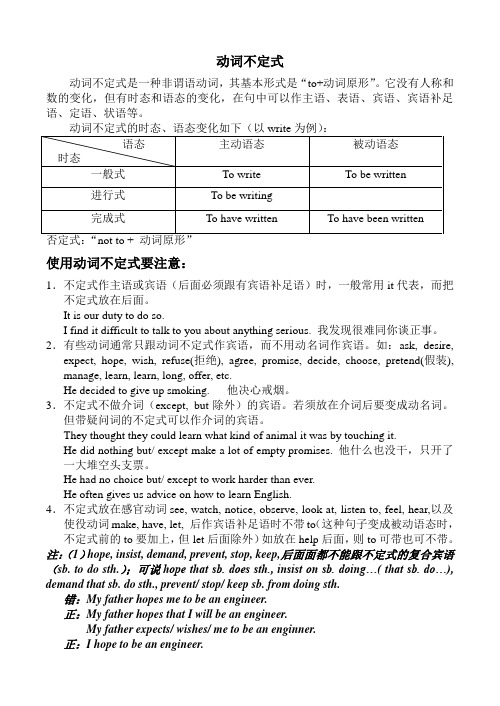
动词不定式动词不定式是一种非谓语动词,其基本形式是“to+动词原形”。
它没有人称和数的变化,但有时态和语态的变化,在句中可以作主语、表语、宾语、宾语补足语、定语、状语等。
使用动词不定式要注意:1.不定式作主语或宾语(后面必须跟有宾语补足语)时,一般常用it代表,而把不定式放在后面。
It is our duty to do so.I find it difficult to talk to you about anything serious. 我发现很难同你谈正事。
2.有些动词通常只跟动词不定式作宾语,而不用动名词作宾语。
如:ask, desire, expect, hope, wish, refuse(拒绝), agree, promise, decide, choose, pretend(假装), manage, learn, learn, long, offer, etc.He decided to give up smoking. 他决心戒烟。
3.不定式不做介词(except, but除外)的宾语。
若须放在介词后要变成动名词。
但带疑问词的不定式可以作介词的宾语。
They thought they could learn what kind of animal it was by touching it.He did nothing but/ except make a lot of empty promises. 他什么也没干,只开了一大堆空头支票。
He had no choice but/ except to work harder than ever.He often gives us advice on how to learn English.4.不定式放在感官动词see, watch, notice, observe, look at, listen to, feel, hear,以及使役动词make, have, let, 后作宾语补足语时不带to(这种句子变成被动语态时,不定式前的to要加上,但let后面除外)如放在help后面,则to可带也可不带。
动词不定式时态用法

动词不定式时态用法动词不定式是一种非谓语动词形式,具有丰富的时态变化。
理解和掌握动词不定式的时态用法对于准确、流利地使用英语至关重要。
一、一般式(to do)动词不定式的一般式(to do)表示的动作通常与谓语动词的动作同时发生或在其后发生。
例如:“I have a lot of work to do”(我有很多工作要做。
)这里“to do”表示的动作是在“have”这个动作之后发生的。
再比如:“He decided to go abroad”(他决定出国。
)“decided”和“to go”几乎是同时发生的动作。
一般式还用于表达将来的动作,这种将来的意味往往是基于当前的计划或安排。
比如:“We are going to build a new house next year The materials to be used have been prepared”(我们明年要建一座新房子。
要用的材料已经准备好了。
)这里“to be used”表示将来要被使用的材料。
二、进行式(to be doing)动词不定式的进行式(to be doing)表示的动作与谓语动词的动作同时进行。
例如:“He pretended to be reading when I came in”(我进来时,他假装在读书。
)“pretended”和“to be reading”是同时发生的。
这种时态用法强调的是动作正在进行的过程。
三、完成式(to have done)动词不定式的完成式(to have done)表示的动作发生在谓语动词的动作之前。
比如:“I'm sorry to have kept you waiting so long”(很抱歉让你等了这么久。
)“to have kept”发生在“am sorry”之前。
再看这个例子:“She is said to have studied abroad for two years”(据说她在国外学习了两年。
动词不定式

动词不定式:指由to加上动词原形(而且只能是动词原形)所构成的一种非限定性动词,但在有些情况下to可以省略。
动词不定式在语法功能上可作主语、宾语、宾语补足语、表语、定语和状语。
动词不定式可以作以上各种成分,但它毕竟是动词,所以有动词的属性。
动词不定式及其短语还可以有自己的宾语、状语,虽然动词不定式在语法上没有表面上的直接主语,但它表达的意义是动作,这一动作一定由使动者发出。
这一使动者我们称之为逻辑主语,其形式如下:时态主动形式被动形式一般式 (not) to do (not) to be done完成式 (not) to have done (not) to have been done进行式 (not) to be doing完成进行式 (not) to have been doing不定式的用法:1、不定式作主语注意:为了避免头重脚轻,在许多情况下,通常都将作主语的不定式置于句子后部,而在句首主语位置使用形式主语it。
例如:It is very important to remember this.2、不定式作表语例如:He seems to be ill.注意:不定式作表语主要有三种情况,一是用于seem, appear, prove等系动词之后的不定式(尤其是to be),二是像My job is to sweep the floor. 这样的主语与表语“等价”的情形,三是表示想法、约定、义务、命令、可能性、命运等,如:You are to come when I call.3、不定式作宾语例如:I can not afford to buy a car.注意:①不定式不仅用作动词的宾语,还可用作个别介词(but, except)的宾语。
例如:I had no choice but to wait.②当作宾语的不定式后跟有宾语补足语时,通常要用形式宾语it代替不定式,并将真正的宾语不定式置于宾语补足语之后例如:I find it difficult to learn Japanese well.4、不定式作宾语补足语例如:Who taught you to drive?5、不定式作定语例如:I have a question to ask you.注意:有的名词(如way, chance, right等)后用作不定式可换成of doing sth.如:It is the best way to do (of doing) it.但是以下名词后接不定式作定语时通常不能换成of doing sth.attempt courage decision effort fortune failure invitation wish 6、不定式作状语例如:I went to France to learn French.。
动词不定式详解

非谓语动词之动词不定式(一)动词不定式的一般形式1.不定式的时态:分为一般体(to do),进行体(to be doing),完成体(to have done),完成进行体(to have been doing)。
2.不定式的否定:不定式的否定形式通常是在不定式之前加not、never等否定词。
3.不定式的被动:通常是由to be done和to have been done构成。
(二)不带to的动词不定式1.在情态动词之后:例如must、can、should、need、dare(当need、dare作为主动词时,后面跟带to的不定式)。
特别地:ought to2.在半助动词之后:类似于be sure to、have got to、had better、happen to等。
3.在情态成语之后:a)would rather/would sooner/would just as soon(宁愿、宁可);后跟…than/as…的句子时,译为宁愿…也不愿…,从句中也用不带to的动词不定式。
b)may/might (just) as well;译为不妨,还是…为好c)can’t but/can’t help but;译为必须,不得不d)rather than/sooner than(宁可…也不…),其置于句首时,后跟不带to的动词不定式;放在句中其他位置时,to可加可不加。
4.在“主动词+主动词”固定搭配的第一主动词之后:第二主动词就是不带to的动词不定式,这类搭配常有:make believe(假装);make do with/on(依靠...维持;凑合);let drop/fall(有意无意说出);hear tell of(据说,听说);let slip(无意中泄露,错过)5.在let、make、have等“使役动词+宾语”结构之后:宾语补足语用不加to的动词不定式。
当使役变为被动态时,需要加上带to的动词不定式。
动词不定式

4.The Emperor ordered the wonderful cloth _____ for him without delay. A.to have woven B. to be woven C. to be weaving D. to weave 5.I found the German language hard ____. A.learned B. learning C. to be learned D. to learn
注意:使役动词和感官动词跟不带to的 动词不定式,变为被动时to必须恢复。
(5)定语
不定式作定语时,应放在被修饰词的后面,与所修 饰的词之间有三种关系动宾,主谓,同位: (1)动宾关系
I have a lot of work to do. I have something to say.
(2)主谓关系
动作一直在进行而且可能之后也继续)
(5).He is said to study abroad next year. He is said to be studying abroad now. He is said to have studied abroad before.
三. 用法/ 功能
(1). 主语,相当于名词
不定式概述
不定式由“to+动词原形”构成,其否定形式是 “not/never to do”,不定式可以带宾语或状语 构成不定式短语,没有人称和数的变化,但有时 态和语态的变化。不定式可以作主语、宾语、 状语、表语,定语或独立成分,但不能单独作 谓语。
动词不定式的时态与语态
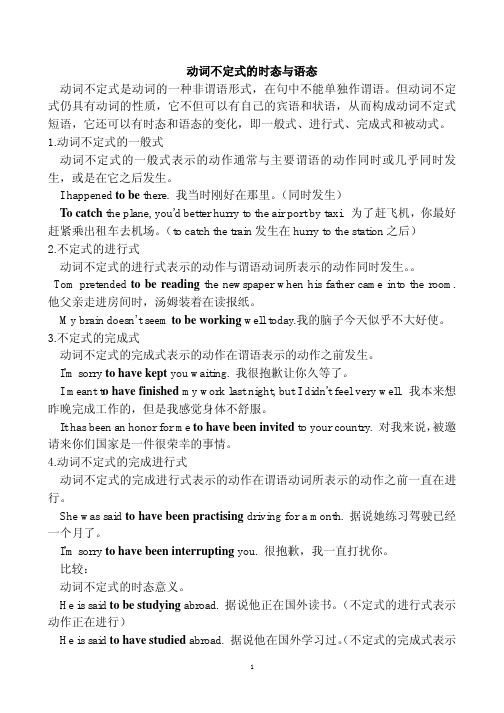
动词不定式的时态与语态动词不定式是动词的一种非谓语形式,在句中不能单独作谓语。
但动词不定式仍具有动词的性质,它不但可以有自己的宾语和状语,从而构成动词不定式短语,它还可以有时态和语态的变化,即一般式、进行式、完成式和被动式。
1.动词不定式的一般式动词不定式的一般式表示的动作通常与主要谓语的动作同时或几乎同时发生,或是在它之后发生。
I happened to be there. 我当时刚好在那里。
(同时发生)To catch the plane, you'd better hurry to the air port by taxi. 为了赶飞机,你最好赶紧乘出租车去机场。
(to catch the train发生在hurry to the station之后)2.不定式的进行式动词不定式的进行式表示的动作与谓语动词所表示的动作同时发生。
Tom pretended to be reading the newspaper when his father came into the room. 他父亲走进房间时,汤姆装着在读报纸。
My brain doesn’t seem to be working well today.我的脑子今天似乎不大好使。
3.不定式的完成式动词不定式的完成式表示的动作在谓语表示的动作之前发生。
I'm sorry to have kept you waiting. 我很抱歉让你久等了。
I meant t o have finished my work last night, but I didn't feel very well. 我本来想昨晚完成工作的,但是我感觉身体不舒服。
It has been an honor for me to have been invited to your country. 对我来说,被邀请来你们国家是一件很荣幸的事情。
4.动词不定式的完成进行式动词不定式的完成进行式表示的动作在谓语动词所表示的动作之前一直在进行。
动词不定式的用法

I am the only man to hear the news.
(6)作状语 ①作原因状语 结构:主语+be+adj.+to do (形容词多为表示情绪或状态的形容 词)
I am sorry to hear you were ill.
We hurried to the station only to be told that the train had left. 我们急匆匆 赶到车站,结果被告知火车已经开走了。
④作评论性状语 to be honest, to tell the truth, to cut a long story short, to put it another way
Mary seems to be thinking deeply.
玛丽似乎在沉思。
(4)不定式的被动形式 当动词不定式的逻辑主语是不定
式所表示的动作的承受者时,一般 要用其被动形式。
The radio needs to be repaired. 收音机需要修理。
2.不定式的句法功能 不定式相当于名词、形容词、副
to be done
完成式
to have done
to have been done
进行式
to be doing
——
完成进行式 to have been doing
——
注意:否定形式是在不定式符号to前加not
(1) 不定式的一般式 表示的动作通常时间性不强,
与谓语动词表示的动作没有时间 先后顺序。
(3)作表语 可以表示主语的具体内容、目的等。
My wish is to have a job in an office. 我的愿望是有一份在办公室里的工作。
动词不定式 语态时态
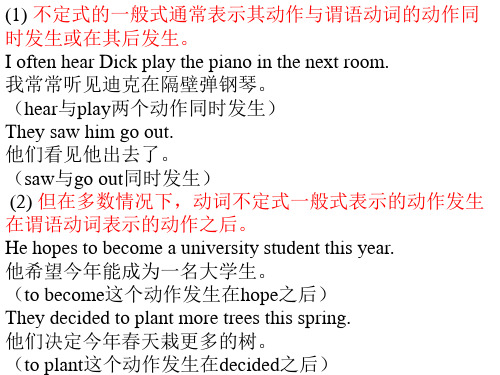
No harm seems to have been done. 似乎并没有造成损害。(作表语) I wish to be sent to work in the country. 我希望被派往乡下工作。(作宾语) In 1924 Nellie Taylor Ross of Wyoming became the first woman to be elected governor in the United States. 1924年,怀俄明州的内利· 泰勒· 罗斯成为美国第一位当选 州长的妇女。(作定语) I had to shout to be heard. 我大声呼喊以便能被听得见。(作状语) He did not like his intention to be laughed at. 他不喜欢他的意图被人取笑。(作宾语补足语) It’s a great honour to be invited to Mary’s birthday party. 被邀请参加玛丽的生日聚会十分荣幸。(作主语)
(3) 不定式的进行式通常表示其动作与谓语动词的动作同 时发生。 My supervisor happened to be correcting my dissertation when I came in. 当我进来的时候,碰巧我的导师在修改我的论文。 They seemed to be discussing something important. 他们似乎在讨论重要的事情。 (4) 不定式的完成式通常表示其动作在谓语动词的动作之 前完成。 I’m sorry to have kept you waiting. 很抱歉,让你久等了。 (to have kept发生在am所表示的时间之前) Robert is said to have written a book on war on Iraq. 听说罗伯特写了一本关于伊拉克战争的书。 (to have written 发生在is said 所表示的时间之前)
不定式的用法和动词不定式的时态
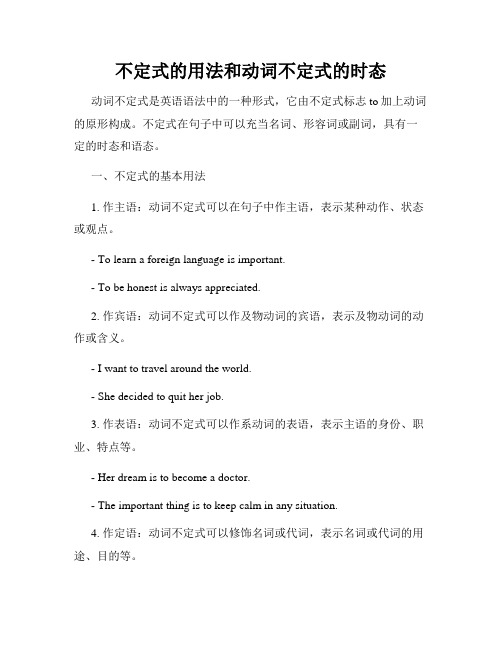
不定式的用法和动词不定式的时态动词不定式是英语语法中的一种形式,它由不定式标志to加上动词的原形构成。
不定式在句子中可以充当名词、形容词或副词,具有一定的时态和语态。
一、不定式的基本用法1. 作主语:动词不定式可以在句子中作主语,表示某种动作、状态或观点。
- To learn a foreign language is important.- To be honest is always appreciated.2. 作宾语:动词不定式可以作及物动词的宾语,表示及物动词的动作或含义。
- I want to travel around the world.- She decided to quit her job.3. 作表语:动词不定式可以作系动词的表语,表示主语的身份、职业、特点等。
- Her dream is to become a doctor.- The important thing is to keep calm in any situation.4. 作定语:动词不定式可以修饰名词或代词,表示名词或代词的用途、目的等。
- I have a book to read.- We have a meeting to attend tomorrow.5. 作状语:动词不定式可以在句中作状语,表示目的、原因、结果、时间等。
- He exercises every day to stay healthy. (目的)- She cried so hard as to lose her voice. (结果)二、动词不定式的时态动词不定式有两种时态:一般时和完成时。
1. 一般时不定式:使用动词的原形表示不定式的一般时态。
- I hope to visit my grandparents next week.- She likes to read books in her free time.2. 完成时不定式:使用动词的完成时形式,由“to have + 动词的过去分词”构成。
时态动词不定式汇总12

(2)在现代英语中dare常用作行为动词,其变化与一般 行为动词相同,构成形式:dare to do something.如: • She dares to stay at home alone at night.晚上她不 敢独自呆在家里。
(2)“be + 过去分词”构成被动语
态; • eg. The room is being cleaned.这个房间 正在被打扫。
• (3)“be + 动词不定式”构成复合谓语 • ①表示按计划安排要发生的事。 • Eg. The chairman is to visit Japan next
year. 主席将于明年访问日本。 • ② 用于命令。 • Eg. You're to do your homework before you watch TV.你得做完了作业才能看电视。
• 1、表示一种习惯性的永久性的或者反复发
生的动作。 • I go to school by bike every day. • 我每天骑自行车去上学。 • 2、表示客观真理、科学事实、格言及不受 时间限制的客观存在。 • Light travels faster than sound. • 光传播的速度比声音快。
• 1. Johnny, you _______ play with the knife, you _______
• • •
• • • • • • •
hurt yourself. A. won‘t; can‘t B. mustn‘t; may C. shouldn‘t; must D. can‘t; shouldn‘t 2. —When can I come for the photos? I need them tomorrow afternoon. —They _______ be ready by 12:00. A. can B. should C. might D. need 3. —I stayed at a hotel while in New York. —Oh, did you? You _______ with Barbara. A. could have stayed B. could stay C. would stay D. must have stayed
动词不定式的时态
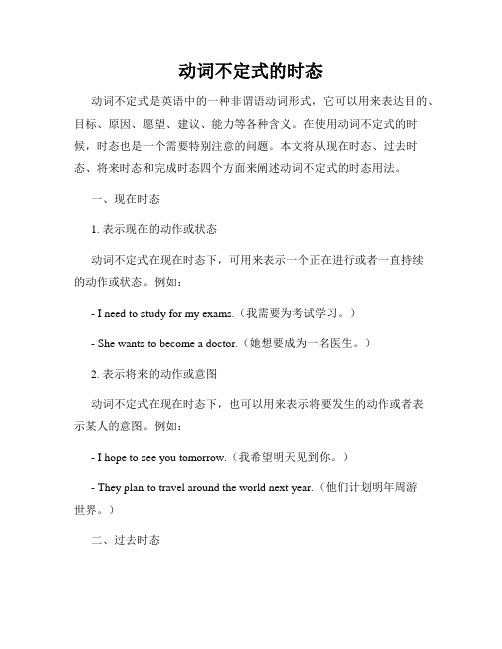
动词不定式的时态动词不定式是英语中的一种非谓语动词形式,它可以用来表达目的、目标、原因、愿望、建议、能力等各种含义。
在使用动词不定式的时候,时态也是一个需要特别注意的问题。
本文将从现在时态、过去时态、将来时态和完成时态四个方面来阐述动词不定式的时态用法。
一、现在时态1. 表示现在的动作或状态动词不定式在现在时态下,可用来表示一个正在进行或者一直持续的动作或状态。
例如:- I need to study for my exams.(我需要为考试学习。
)- She wants to become a doctor.(她想要成为一名医生。
)2. 表示将来的动作或意图动词不定式在现在时态下,也可以用来表示将要发生的动作或者表示某人的意图。
例如:- I hope to see you tomorrow.(我希望明天见到你。
)- They plan to travel around the world next year.(他们计划明年周游世界。
)二、过去时态动词不定式在过去时态下,主要用于表达过去某一时刻的意图、计划或者希望等。
例如:- I wanted to visit my grandparents last weekend, but I was too busy.(上周末我想去看望我的祖父母,但是我太忙了。
)- He hoped to find a new job, but it was not easy.(他希望找到一份新工作,但这并不容易。
)三、将来时态动词不定式在将来时态下,主要用于表达将来某一时刻的意图、计划、要求以及命令等。
例如:- We are going to meet at the park tomorrow.(我们明天打算在公园见面。
)- The teacher expects us to finish the project by the end of the week.(老师希望我们在本周结束之前完成这个项目。
动词不定式
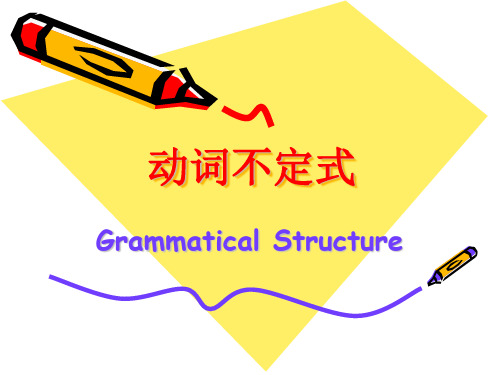
want, like ,wish, hope, prefer ,ask, offer, promise , pretend(假装), intend(打算), decide , plan, refuse, tend(趋向, 照料)等.
Grammatical Structure
Grammatical Structure
还可以用于双宾语:
I asked him how to learn English. 我问他如何学习英语.
Grammatical Structure
“口诀” 谓语之外均担任,用作谓语需合成。 动词特征似保留,宾语、状语照样跟。 时态、语态酌情用,动作先后注区分。
Grammatical Structure
⑥作宾语补足语
The teacher advised us to have a rest first.
She encouraged me to try again.
Grammatical Structure
B). see, hear, feel, listen to, look at, make做不 带to的不定式作宾语补足语.
动词不定式
Grammatical Structure
Grammatical Structure
1.动词不定式的特点及构成 2.动词不定式的时态及语态 3.动词不定式的语法功能
动词不定式 动词不定式特点:
1.不能单独作谓语. 2.可做主语、表语、定语、宾语、 宾语补足语和状语 动词不定式的构成:
to + 动词原形 to study. to work, to know
Did you notice a man come in?
动词不定式时态
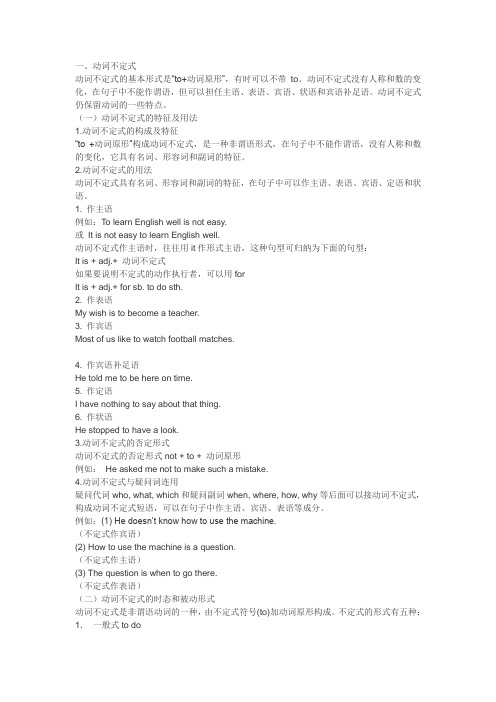
一、动词不定式动词不定式的基本形式是“to+动词原形”,有时可以不带to。
动词不定式没有人称和数的变化,在句子中不能作谓语,但可以担任主语、表语、宾语、状语和宾语补足语。
动词不定式仍保留动词的一些特点。
(一)动词不定式的特征及用法1.动词不定式的构成及特征“to +动词原形”构成动词不定式,是一种非谓语形式,在句子中不能作谓语,没有人称和数的变化,它具有名词、形容词和副词的特征。
2.动词不定式的用法动词不定式具有名词、形容词和副词的特征,在句子中可以作主语、表语、宾语、定语和状语。
1. 作主语例如:To learn English well is not easy.或It is not easy to learn English well.动词不定式作主语时,往往用it作形式主语,这种句型可归纳为下面的句型:It is + adj.+ 动词不定式如果要说明不定式的动作执行者,可以用forIt is + adj.+ for sb. to do sth.2. 作表语My wish is to become a teacher.3. 作宾语Most of us like to watch football matches.4. 作宾语补足语He told me to be here on time.5. 作定语I have nothing to say about that thing.6. 作状语He stopped to have a look.3.动词不定式的否定形式动词不定式的否定形式not + to + 动词原形例如:He asked me not to make such a mistake.4.动词不定式与疑问词连用疑问代词who, what, which和疑问副词when, where, how, why等后面可以接动词不定式,构成动词不定式短语,可以在句子中作主语、宾语、表语等成分。
动词不定式的时态和语态

动词不定式的时态和语态动词不定式是一种非谓语形式,通常由“to + 动词原型”构成。
它可以用于表示动作、状态或目的。
动词不定式在时态和语态方面也有一些变化。
时态动词不定式有两种时态:一般式和完成式。
**一般式:**一般式动词不定式表示的是一般的、经常性的动作或状态。
它在句子中常常用作主语、宾语、主语补足语、宾语补足语等。
示例:- To walk is good for our health.(走路对我们的健康有好处。
)(作为主语)To walk is good for our health.(走路对我们的健康有好处。
)(作为主语)- I want to study abroad.(我想出国研究。
)(作为宾语)to study abroad.(我想出国学习。
)(作为宾语)**完成式:**完成式动词不定式表示的是动作或状态已经完成或将来完成的情况。
它通常用于表示某个动作在主句谓语动词之前完成。
示例:- I am happy to have finished my homework.(我很高兴已经完成了作业。
)to have finished my homework.(我很高兴已经完成了作业。
)语态动词不定式也有被动语态和完成被动语态。
**被动语态:**被动语态的动词不定式的构成方式是“to be + 动词的过去分词”。
它表示动作的接受者或经历者而不提及动作的执行者。
示例:- He needs to be reminded of the deadline.(他需要被提醒截止日期。
)to be reminded of the deadline.(他需要被提醒截止日期。
)**完成被动语态:**完成被动语态的动词不定式的构成方式是“to have been + 动词的过去分词”。
它表示过去的动作或状态已经完成且对现在产生影响。
示例:- They are excited to have been selected for the team.(他们很兴奋因为被选入了队伍。
- 1、下载文档前请自行甄别文档内容的完整性,平台不提供额外的编辑、内容补充、找答案等附加服务。
- 2、"仅部分预览"的文档,不可在线预览部分如存在完整性等问题,可反馈申请退款(可完整预览的文档不适用该条件!)。
- 3、如文档侵犯您的权益,请联系客服反馈,我们会尽快为您处理(人工客服工作时间:9:00-18:30)。
一、动词不定式动词不定式的基本形式是“to+动词原形”,有时可以不带to。
动词不定式没有人称和数的变化,在句子中不能作谓语,但可以担任主语、表语、宾语、状语和宾语补足语。
动词不定式仍保留动词的一些特点。
(一)动词不定式的特征及用法1.动词不定式的构成及特征“to +动词原形”构成动词不定式,是一种非谓语形式,在句子中不能作谓语,没有人称和数的变化,它具有名词、形容词和副词的特征。
2.动词不定式的用法动词不定式具有名词、形容词和副词的特征,在句子中可以作主语、表语、宾语、定语和状语。
1. 作主语例如:To learn English well is not easy.或It is not easy to learn English well.动词不定式作主语时,往往用it作形式主语,这种句型可归纳为下面的句型:It is + adj.+ 动词不定式如果要说明不定式的动作执行者,可以用forIt is + adj.+ for sb. to do sth.2. 作表语My wish is to become a teacher.3. 作宾语Most of us like to watch football matches.4. 作宾语补足语He told me to be here on time.5. 作定语I have nothing to say about that thing.6. 作状语He stopped to have a look.3.动词不定式的否定形式动词不定式的否定形式not + to + 动词原形例如:He asked me not to make such a mistake.4.动词不定式与疑问词连用疑问代词who, what, which和疑问副词when, where, how, why等后面可以接动词不定式,构成动词不定式短语,可以在句子中作主语、宾语、表语等成分。
例如:(1) He doesn’t know how to use the machine.(不定式作宾语)(2) How to use the machine is a question.(不定式作主语)(3) The question is when to go there.(不定式作表语)(二)动词不定式的时态和被动形式动词不定式是非谓语动词的一种,由不定式符号(to)加动词原形构成。
不定式的形式有五种:1.一般式to do例如:I like to read English.2.进行式to be doing例如:He seemed to be reading something at that time.3.完成式to have done例如:He seemed to have cleaned the room.4.被动式to be done例如:The work is to be done soon.5.完成被动式to have been done例如:The boy is said to have been sent to hospital yesterday.复习时需注意的要点1.动词不定式一般式表示的动作可能与谓语动词的动作同时发生,也可能在其之后发生。
例如:I saw the young man enter the house.(同时发生)I hope to go there next time.(之后发生)2.不定式完成式表示不定式的动作在谓语动词之前发生。
例如:I’m sorry t o have broken your glasses.3.不定式进行式表示不定式的动作,与谓语动词同时发生。
例如:When he came in, I happened to be reading at the table.4.不定式的被动式有两种形式:to be done表示将要被做,to have been done表示已被做。
例如:The new cinema to be put up next year will be very large.The cinema is said to have been built last year.5. 在表示情绪的动词,如like, love, hate, prefer等后,用动名词作宾语表示一般倾向,用不定式表示特定某事。
但在would/should like/love/prefer后要用不定式例如:I hate eating the same food every day.Would you like to watch TV in the evening?6. 在动词need, want, require后用动名词表示被动含义,相当于动词不定式的被动式;而用动词不定式的主动式表示主动含义。
例如:The house needs cleaning. = The house needs to be cleaned.He needs to clean the house first.7. 在介词后一般用动名词作宾语,但在少数介词,如but, except后用动词不定式作宾语,但要注意“to”的省略,如but前有“do”则省去“to”。
例如:I have done nothing but help him with his luggage.I have no choice but to wait for him at the bus stop.历届高考试题分析例1、The discovery of new evidence led to _________.A. the thief having caughtB. catch the thiefC. the thief being caughtD. the thief to be caught答案为C。
【解析】lead to这个词组中to是介词,后面跟名词,于是B被排除,the thief是动名词逻辑上的主语,构成动名词的复合结构,与catch之间应是被动关系,故排除A。
常见的带介词to的短语有:(get) be used to, look forward to,look up to, stick to, object to, be devoted to, pay attention to等。
例2、Though _______money, his parents managed to send him to university.A. lackedB. lacking ofC. lackingD. lacked in答案为C。
【解析】lack是及物动词,后接宾语money。
his parents与lack是逻辑上的主谓关系,要用现在分词作状语。
译文:虽然缺钱,他的父母亲还是设法让他上了大学。
例3、He got well-prepared for the job interview, for he couldn’t risk ____ the good opportunity.A. to loseB. losingC. to be lostD. being lost答案:B【解析】risk后面只能带动名词做宾语,含义为“冒……之险”。
例4、_____ to sunlight for too much time will do harm to one's skin.A. ExposedB. Having exposedC. Being exposedD. After being exposed答案为C。
【解析】在非谓语动词中,用动名词或不定式来作主语,而分词和介词短语不能作主语,因此A、D被排除。
在这个句子中,will do是谓语,缺少主语,要用动名词作主语。
expose 与one's skin是动宾关系,所以要用动名词的被动式being exposed。
译文:在阳光下晒太长时间对人的皮肤有坏处。
例5、____ into use in April 2000, the hotline was meant for residents reporting water and heating supply breakdowns.A. PutB. PuttingC. Having putD. Being put答案:A【解析】put sth. into use “让……投入使用”。
显然,put 和句子主语the hotline 构成被动关系,所以用表示被动的过去分词。
例6、It was unbelievable that the fans waited outside the gym for three hours just ____ a look at the sports stars.A. hadB. havingC. to haveD. have答案:C【解析】动词不定式充当目的状语。
例7、With a lot of difficult problems _______, the newly-elected president is having a hard time.A. settledB. settlingC. to settleD. being settled答案为C【解析】动词不定式to settle作为difficult problems的定语表示现在或将来要解决的难题;过去分词settle作定语表示已经解决的难题,现在分词的被动式being settled作定语表示正在解决的难题。
例8、More and more people are signing up for Yoga classes nowadays, ____ advantage of the health and relaxation benefits.A. takingB. takenC. having takenD. having been taken答案:A【解析】take advantage of (利用)和句子主语More and more people 构成主动关系,且和句子谓语sign up for (报名参加)同时发生,所以选择A。
例9、Sandy could do nothing but ________ to his teacher that he was wrong.A. admitB. admittedC. admittingD. to admit答案为A。
【解析】该句中的but是介词,后接动词不定式。
当谓语动词是do,does或did时,后接不带to的不定式;是其他动词时,后接带to的不定式。
